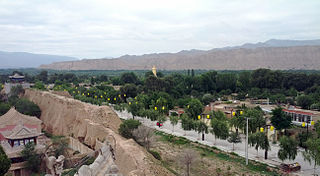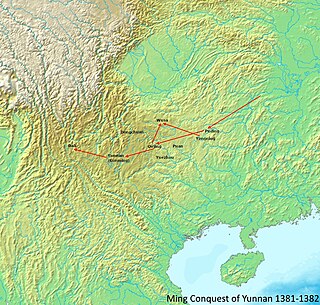Related Research Articles

The Xia dynasty is the first dynasty in traditional Chinese historiography. According to tradition, the Xia dynasty was established by the legendary Yu the Great, after Shun, the last of the Five Emperors, gave the throne to him. In traditional historiography, the Xia was later succeeded by the Shang dynasty.

The Grand Canal, known to the Chinese as the Jing–Hang Grand Canal, a UNESCO World Heritage Site, is the longest canal or artificial river in the world. Starting in Beijing, it passes through Tianjin and the provinces of Hebei, Shandong, Jiangsu, and Zhejiang to the city of Hangzhou, linking the Yellow River and Yangtze River. The oldest parts of the canal date back to the 5th century BC, but the various sections were first connected during the Sui dynasty. Dynasties in 1271–1633 significantly restored and rebuilt the canal and altered its route to supply their capital. The Grand Canal played a major role in reunifying north and south China. The canal was built by conscripted laborers and connected the Yellow River in the north with the Yangtze River in the south, which made it much easier to transport grain from the south to the centers of political and military power in north China.

The Yellow River or Huang He is the second-longest river in China, after the Yangtze River, and the sixth-longest river system in the world at the estimated length of 5,464 km (3,395 mi). Originating in the Bayan Har Mountains in Qinghai province of Western China, it flows through nine provinces, and it empties into the Bohai Sea near the city of Dongying in Shandong province. The Yellow River basin has an east–west extent of about 1,900 kilometers (1,180 mi) and a north–south extent of about 1,100 km (680 mi). Its total drainage area is about 795,000 square kilometers (307,000 sq mi).

Yu the Great (大禹) was a legendary king in ancient China who was famed for his introduction of flood control, his establishment of the Xia dynasty which inaugurated dynastic rule in China, and his upright moral character. He figures prominently in the Chinese legend of "Great Yu Who Controlled the Waters".
The 1642 Yellow River flood or Kaifeng flood was a man-made disaster in October, 1642, that principally affected Kaifeng and Xuzhou.
Yishiha was a Jurchen eunuch of the Ming dynasty of China. He served the Ming emperors who commissioned several expeditions down the Songhua and Amur Rivers during the period of Ming rule of Manchuria, and is credited with the construction of the only two Ming dynasty Buddhist temples ever built on the territory of present-day Russia.

Guide County is a county in the east of Qinghai Province, China. It is under the administration of Hainan Tibetan Autonomous Prefecture. In Tibetan it's known as Trika. In 2015 it had a population of 108,800, of which 37.8% Tibetans, and 16.1% other ethnic minorities. In 2018 the population was 110,900.
Yuwangtai District is a district of the city of Kaifeng, Henan province, China.

The Ming conquest of Yunnan was the final phase in the Ming dynasty expulsion of Mongol-led Yuan dynasty rule from China proper in the 1380s.
The 1384 Yellow River flood was a natural disaster affecting the area around Kaifeng, China, during the early Ming dynasty.
The 1390 Yellow River flood was a natural disaster affecting the area around Kaifeng, China, during the early Ming dynasty.
The 1410 Yellow River flood was a natural disaster affecting the area around Kaifeng, China, during the early Ming dynasty.
The 1416 Yellow River flood was a natural disaster affecting the area around Kaifeng, China, during the early Ming dynasty. The flood spilled over into fourteen other counties and seriously disturbed the Huai River.
The 1441 Yangtze flood was a natural disaster affecting the area around Nanjing, China, during the Ming dynasty.

The 1344 Yellow River flood was a major natural disaster during the Yuan dynasty of Imperial China. The impact was devastating both for the peasants of the area as well as the leaders of the empire. The Yuan dynasty was waning, and the emperor forced enormous teams to build new embankments for the river. The terrible conditions helped fuel rebellions that led to the founding of the Ming dynasty.
The 1391 Yellow River flood was a major natural disaster during the early Ming dynasty in China.
The 1448 Yellow River flood was a major natural disaster affecting over 2000 li of the Yellow River. The flood threatened to destroy the Grand Canal port of Linqing and led to the Ming dynasty constructing major public works in Shawan to prevent a recurrence. The banks and dikes only lasted four years until the 1452 flood.
The 1452 Yellow River floods were major natural disasters affecting hundreds of thousands of farmers along the Yellow River in Shandong and Henan, as well as the Huai River valley.
The 1453 Yellow River flood was a natural disaster in the area surrounding Shawan in Shandong, China, during the Ming dynasty. The banks – repaired just the year before – burst again in the fourth lunar month and again in the fifth.

The 1494 Yellow River flood was a natural disaster in China during the Ming dynasty.
References
- ↑ Tsai, Shih-Shan Henry.SUNY Series in Chinese Local Studies: The Eunuchs in the Ming Dynasty . SUNY Press, 1996. ISBN 0791426874, 9780791426876. Accessed 16 Oct 2012.